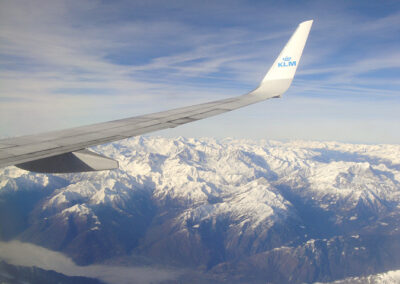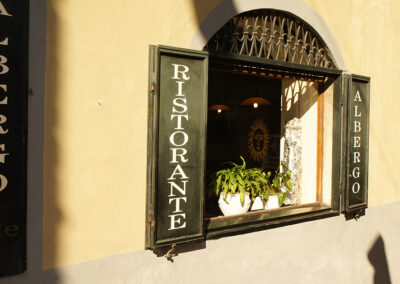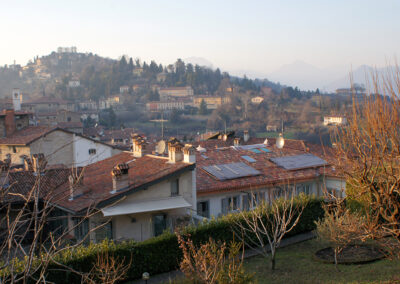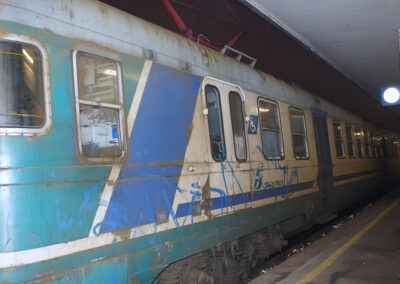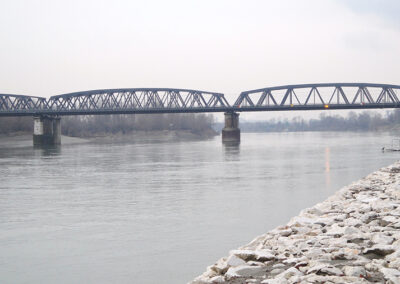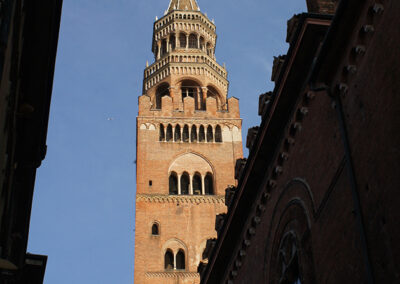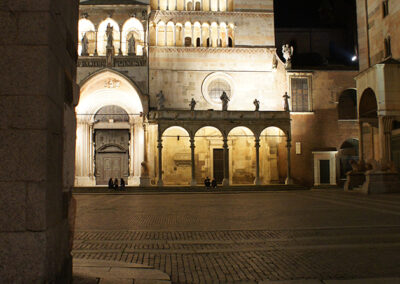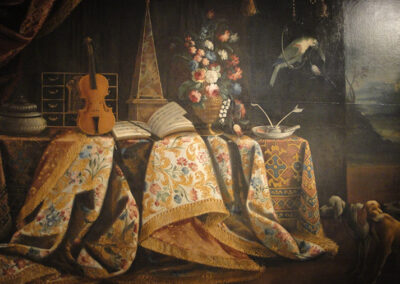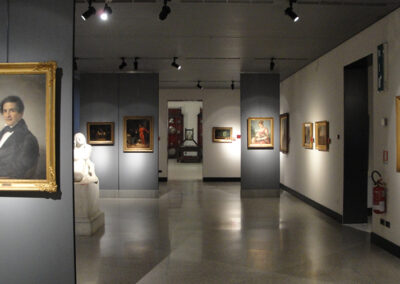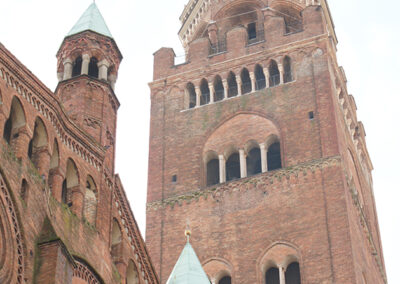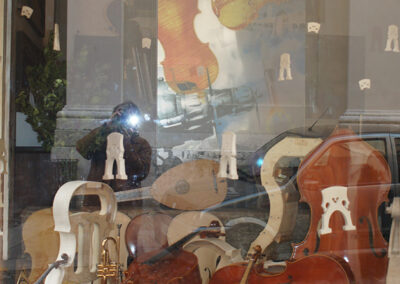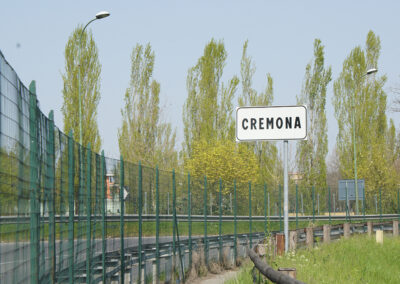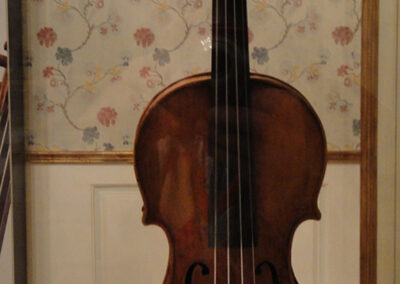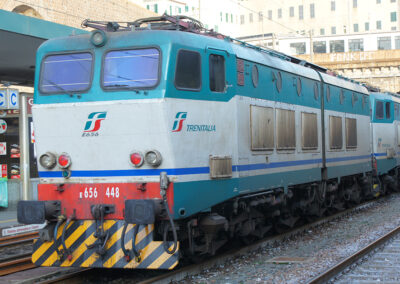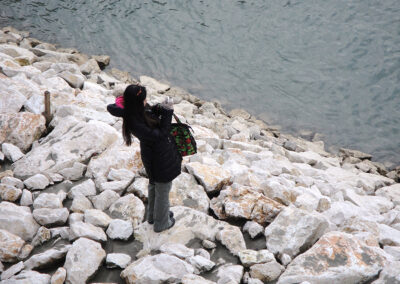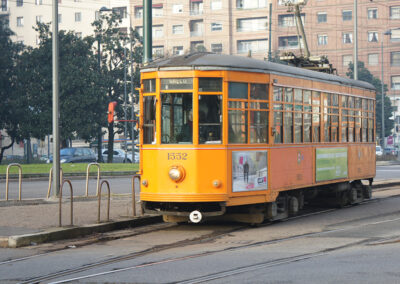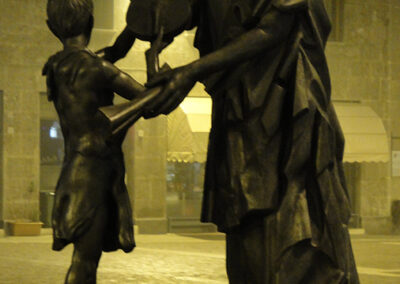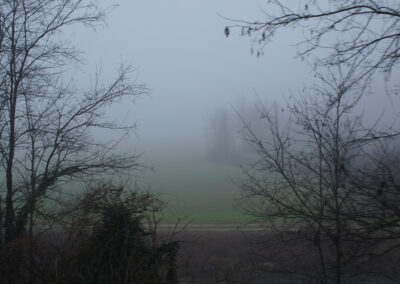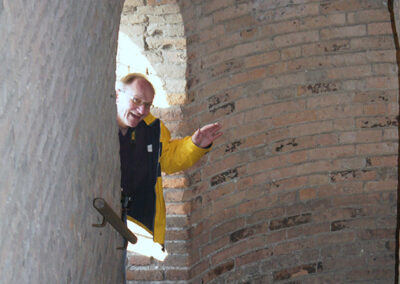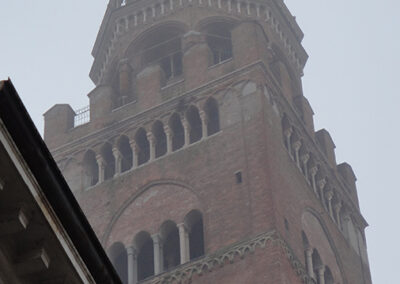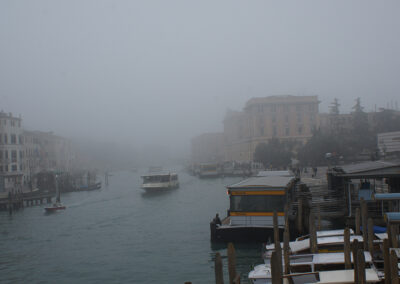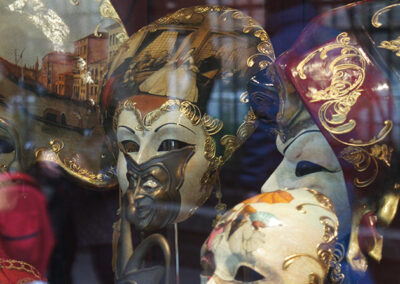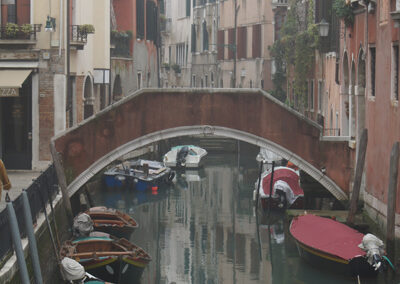Trips
Our Trip to Cremona:
ONE FRIGID JANUARY EVENING Marie-Helene I and boarded KLM’s mixed passenger cargo overnight flight from Toronto to Amsterdam. After a brief delay- well just over an hour (I suppose they were loading more beaver pelts, or cases of maple syrup, or whatever it is we send to Europe)- we were on our way. Six and a half hours later we landed at Amsterdam’s ultramodern Schipol airport. Now, I’ve always enjoyed the slightly-stoned feel of airports in general, and of no-sleep-next morning European airports in particular. So, this was truly a great start to our trip!
I don’t remember clearing European customs: it seems to have been painless enough (but then maybe we looked too tattered to seem suspicious). We thought we were going to be late for our connecting flight and so booted it at top speed to the connecting gate. It turned out, however, that we had mistaken the boarding time for the takeoff time, so in the end we had a half hour to kill (Well, note to self: learn how to read an airline ticket one of these days). In any event we shortly boarded a KLM 737 for a lovely flight over the Swiss Alps. After an hour and a half or so, we landed at Milan’s Malpensa airport. As with all airports, it seems as if one has to walk forever to reach an exit, and in addition, Malpensa is perhaps a bit gloomier than most other airports are, with its corridors painted in an uninviting hospital green. Finally we did find the exit; it was there all along (Just follow the carbinieri). Then an hour or so bus ride into Milan itself, where we hopped off at the Centrale railway Station.
I had not been in Europe for a great many years, and the first thing I noticed is just how crowded everything seemed, at first, to my North American eyes. Of course the European cityscape differs greatly from the North American; everything is much, much older, and there are few, if any high rises or skyscrapers, for a start. Being older and definitely pre-automobile, the motor car is much less prominent. And like many European cities, Milan is criss-crossed with street railway lines, and the street cars themselves are of the squat old-fashioned variety that seem to find favour in Continental cities. We made our way to our very tiny hotel by taxi cab, and were given a room with a view on an interior court yard. Again as a North American, I found the crowded, pokey little room depressing, and was anxious to go outside as soon as possible (then again, travel always leaves me restless!). Very close to our hotel, which itself faced onto the Bastioni Porta Venezia, we bumped into what has to be the largest bookstore in the world (Foyles of London not withstanding!); this set me to longing for the summer break from teaching, when I usually get down to the mountain of books that have accumulated and are awaiting my attention. However, I digress, and let me just add that after a dinner in a very nice restaurant close to our hotel, we made an early night of it. After thirty-six non-stop hours, even I fell right to sleep.
The next morning we set off on TrenItalia’s regional service for Cremona. The regional services seem to constitute a kind of commuter network; you buy your ticket at the counter and then cancel it tin a machine just before you board. The trains themselves are nothing to write home about, although they did in general run right on time, and at least by Canadian standards, the fares are very reasonable. Arriving in Cremona, a quick nip through a underpass (or “subway”, as they are called in Britain) brings you to the Cremona station itself: stolid, massive, and like everything else in Italy, built to last. Since we were getting picked up by the owners of the apartment we had rented, we didn’t have to wait for a cab. And after a short wait, along they came, in one of those tiny European cars, no less. By means of gestures (no, neither of us speaks proper Italian), we understood that we were to pile our packs and assorted trinkets in the trunk. After we had so done, we were off a fair clip around a series of ring roads that surround the old city centre. I was under the impression that the guide book had stated something like “ten minutes on foot from the apartment to the station”, and I was wondering how far away it really was, when the owner explained that we actually had to circle the town because of a series of one way roads, Ah, how like Canada after all!
We finally arrived at the apartment. Once again the impression I received was one of permanence and solidity. The interior courtyard was constructed entirely of cement, as were the inner galleries and stairwells. This is all so different from Canada with its preponderance of frame housing. I remember wondering to myself if the Italians had perhaps cut down all their forests, as the early Icelanders are reported to have done. That would account, in any case, for the heavy-duty construction methods so in evidence.
After a quick trip to the supermarket to pick up milk, bread, coffee, wine (turned out I selected that wretched, fizzy red swill that people in Italy seem to be able to tolerate!), and having inhaled a bit of pizza from the bakery downstairs, we set out to explore Cremona on foot. In this, we were not alone. In Cremona, people walk. And by people, I mean everyone: young, old, well-dressed- which counts most people in the north of Italy- and the poor. They also cycle. Not the modified trail bikes so popular in Canada, but simple, old bikes. Many have baskets on the front handlebars for carrying provisions, which the people do, enthusiastically. It was a fairly dark, overcast afternoon, and visibility was not great.
So it would be hard to describe the surprise of walking south on Via Solferino, when suddenly the bulk of the Torrazzo looms up from behind a shop façade, appearing out of the mists like the hull of some medieval ship (in fact, the construction of the Tower goes back to the Middle Ages.) Actually, the Torrazzo is so dominating a feature that it may be seen from almost any point in Cremona. But, then, I suppose people quickly become accustomed to living in close proximity to such a treasure (kind of like those folks who live beside Niagara Falls, or the Pacific Ocean, I suppose). Well, in our particular case, night came eventually, and early too, as we were a bit north of where we live in Northumberland (for anyone who is curious, Cremona is on roughly the same latitude as Midland, Ontario). Shortly after dark, a heavy fog fell over the town (think London, walking along The Embankment).While my wife stayed behind in the apartment, I set out to do some night photography. Of course I was most of all interested in photographing the Torrazzo: Hey, gigantic, shrouded in mist, it doesn’t get any better. This is photography at its creepy best. And the soundscape! Too bad I was only equipped with a still camera. The heavy, moist air and solid stone construction of the Piazza del Comune (“Town Square”) amplified every tiny sound, so that a small band of teenagers hooting sounded like an invading army. Well, that may be overstating the case, but you get the idea…….
Sunday morning dawned, the air heavy and the sky overcast. We decided to visit the Stradivari Museum. Perhaps because I don’t know a great deal about violin making, I found the visits to museums and collections less interesting than the photography that I was able to pursue out of doors. Nevertheless, I can’t leave the subject of museums without pointing out that, this being Italy, all museums- including the Cremona Town Museum, where the Stradivari Museum is located- contain an almost unimaginable wealth of oil paintings. We dedicated several hours of our visit to these paintings.
The next few days were spent on day trips to the neighbouring cities of Venice, Genoa, and, of course, Milan. (The economy and frequent service that characterize TrenITalia render such trips quite manageable). These small trips all turned out to be very interesting. In Venice we saw, well, canals, tourists, pigeons…in whatever order you like. In Genoa, which in its hustle and bustle makes quite a contrast with Cremona, we of course went to see Paganini’s violin. (The museum staff were, however, clever enough to route us through several miles of oil paintings before we were able to enter the inner sanctum, where “The Cannon” is stored.) As it turned out, we didn’t have nearly enough time to see much of Genoa itself…..well, next visit!
After a few days of travelling, we decided to stay in Cremona for a day in order to rest up. This was in anticipation of the arrival from Hungary of some old friends of ours, who were coming to spend a few days in Italy. On our day off I walked down the Viale Po to the riverbank. Although not the St. Lawrence, the Po is certainly an impressive river. It is broad and very sombre. I came across some sort of touristy “party boat”, though it was of course moored up for the winter season. There is also a small yacht club, but it was also closed. All in all, there were not many people about this being the middle of January, only the odd soul here and there, who I took to be a tourist, like myself.
The next day I picked our friends up at the railway station. We were able to spend a few days in standard, tourist-type activities, most especially photography (an industry in which my buddy and I have both worked). Our course the high point of our time came, quite literally, when we climbed the Torrazzo. Not as formidable a task as I had supposed, I’m happy to report. Just an hour’s battle with claustrophobia on my part (those interior staircases are just so narrow!) Fortunately it was a nice day, and from the top we could see as far as the Po River in the south, and across the farm plain all the way to the horizon in the north. We were therefore able to do a great deal of photography. [As an aside I might mention how beautiful the winter light is in Italy, a soft, “infusive” light, perhaps as a result of the Northern latitude combined with so much seawater close at hand. I’ve photographed in many seaside locations, and have always noticed how wonderfully the water reflects the light back into the sky, which in turn scatters the light and returns it to earth like a giant diffuser.] But to get back to the tower: I’m told that it was destroyed by an earthquake in 1117 (I believe) and then rebuilt. If this is true, then we can only marvel at the tenacity of those who went before us. How can we even begin to imagine what went through the minds of those workmen- ant like in their devotion- who gave over their entire working lives to adding, what, a storey or more to the massive construction, a structure that they would never live to see completed? But, as I say, Italy was built to last.
Our trek up the tower left us ravenous, so we retired to the Ristorante Centrale for dinner. Now, this is an authentic Italian restaurant where what-you-order-is-what-you-get. (My friend ordered roast beef, and that’s what he got: a lonely chunk of beef on his plate. Note to self and others: in Italy, sides must be ordered separately.) I was, however, able to enjoy Mostarda, a local specialty involving fruits preserved in mustard, or something like that. Mostarda is like many culinary specialties that we came across in Northern Italy, in that it was totally unfamiliar to me and my St. Clair Avenue West background, I.e., the Southern Italian culture of Toronto.
Our last day in Italy was given over to our trip to Bergamo to see off our friends, who were flying back to Budapest. This incomparably beautiful little city- a medieval city-state actually, like most Northern Italian cities- could easily take up an article all to itself, so perhaps we’ll leave that for another day.
Now, if you’ve made it to the end of this little essay, you might be wondering why I’ve spent so much time talking about architecture and photography. First of all, I‘m no expert in the field of violin making, and cannot even begin to imagine the skill that goes into the hand manufacture of such a complex object. But beyond this obvious fact, my rounds in the luthier shops and rather unsuccessful attempts to do business with the “Consortium” of Cremona violin makers left me with a feeling that perhaps the whole enterprise of attempting to revive the violin making traditions of historic Cremona has something a mannerism about it. (During my two-week visit I did not meet a single violin teacher or student, nor did I see any signs or ads posted for violin teachers, or hear anyone practicing. It‘s true that the town has someone come into the museums and play the old master fiddles every week or two, but this seems only one more aspect of the “museum culture” that rules the town.) In my mind, I twinned Cremona with that other small city on the same latitude, one that I mentioned before, Midland, Ontario. I thought of Cremona’s many violin maker shops, and remembered Midland’s reconstructed missions, Native Museums and bookstores, all with the attached handicraft shops selling native artefacts. Now, no-one thinks of Midland as an authentic seventeenth century town, and so should we think of Cremona as a real, working centre of violin making? Well I’ll leave this question to minds that are more attuned to the subject than mine. In the meantime, I have a sneaking suspicion that the real centres of modern violin making are probably located in Asia and North America, leaving the European continent as a kind of “Musee des Beaux-Arts“. What is beyond question, however, is the fact of Europe’s uncanny physical beauty. North America and Asia might be the power houses of the world, but Europe is that darling of all photographers: the beautiful, seductive model.
To view the photographs from the Trip to Cremona, please click on: www.flickr.com/photos/richardtweney.

